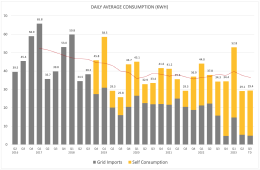lonestarcanuck
New Member
Note - I live in Texas just north of Houston.
Currently, I have 1500 (5x315w) PV tied to a 1000W grid-tie inverter.
Goal to reduce my 60-100kWh (daily peek around 9100w) per day grid consumption by at least half and also have essential circuits on battery in case of Power outages.
I would like to do this in steps, maybe a 6000W inverter on one leg (120v) and eventually add a 2nd inverter (6000) on leg 2 (120v) for a combined L1/L2 = 240v at 12000w with 5 to 20kWh of battery (48v)
dilemma - we lose power at most we are down 2-10 hours per year - I live in the country. Ignore the winter a few years ago - that was once in 100 years.
Because of this dilemma, I am leaning towards a grid-tie and a possible UPS for essential circuits.
I am looking for some ideas or recommendations on maybe a Hybrid inverter that allows the best of both worlds or anyone else in similar situation and what you are doing?
Currently, I have 1500 (5x315w) PV tied to a 1000W grid-tie inverter.
Goal to reduce my 60-100kWh (daily peek around 9100w) per day grid consumption by at least half and also have essential circuits on battery in case of Power outages.
I would like to do this in steps, maybe a 6000W inverter on one leg (120v) and eventually add a 2nd inverter (6000) on leg 2 (120v) for a combined L1/L2 = 240v at 12000w with 5 to 20kWh of battery (48v)
dilemma - we lose power at most we are down 2-10 hours per year - I live in the country. Ignore the winter a few years ago - that was once in 100 years.
Because of this dilemma, I am leaning towards a grid-tie and a possible UPS for essential circuits.
I am looking for some ideas or recommendations on maybe a Hybrid inverter that allows the best of both worlds or anyone else in similar situation and what you are doing?



